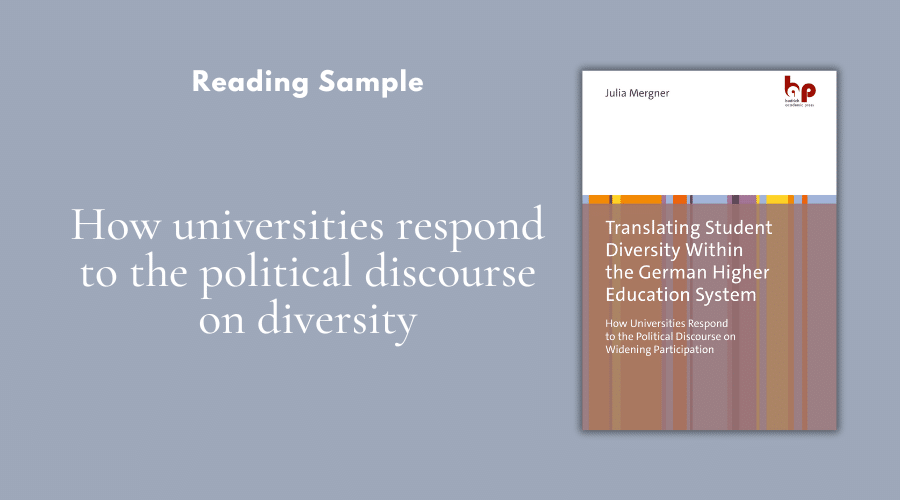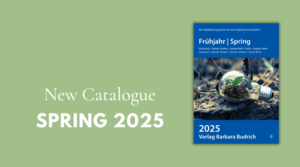How do universities respond to the institutional demand to deal with an increasingly heterogeneous student body? A reading sample from “Translating Student Diversity Within the German Higher Education System. How Universities Respond to the Political Discourse on Widening Participation” by Julia Mergner. Read a snippet from the second chapter “Widening Participation in the Context of German Higher Education”.
2.2 Student Diversity in the German Higher Education Context
Due to the wide range of different characteristics that describe the dominant student group, the definition of student diversity is complicated. Overall, there is no “completed catalogue of characteristics” (Wielepp 2013: 365) that can be used to describe the diversity of students as there is an endless variety of possibilities in comparing students. Thus, diversity is no objective feature or characteristic. Diversity is rather always linked to the respective person or group under observation that can be diverse in several respects, depending on the respective features that are used for comparison. Consequently, diversity is alterable and always highly context-related (Seidel 2014).
According to Wilkesmann et al. (2012), how to define non-traditional students depends on the respective national context, the spirit of the time and certain demographic characteristics. Many German higher education studies build on the definition of non-traditional students provided by Teichler/Wolter (2004). They characterize non-traditional students as (1) students who do not enter the higher education system on the traditional ‘direct way’, (2) students who do not fulfill the regular educational requirements for access to higher education and (3) students who do not study in the general full-time format. This resembles a differentiation on the basis of entry routes to higher education, educational biography and the mode of study (Schuetze/Slowey 2002). This definition focuses on the specific German higher education system in which students mostly enter higher education as full-time students directly after attaining the school-based university entrance qualification. Such a definition might help in determining what non-traditional students are not in comparison to the ‘normal’ student, but it leaves a relatively large scope for interpretation. For example, this definition does not include any references to socio-demographic characteristics, although research findings show that these characteristics have a huge impact on the probability of students’ access to and participation in German higher education (Middendorff 2015). Further, longitudinal studies indicate that there is an increasingly large proportion of students who study full-time, although they have other obligations in addition to their studies (Middendorff et al. 2013). These students would not be defined as non-traditional according to the definition previously mentioned, although it is likely that they are particularly challenged by their studies. Finally, psychological higher education research emphasizes that apart from these ‘visible’ characteristics, there are also ‘invisible’ individual characteristics to differentiate students, for example, according to their motivations, academic competences and study expectations (Middendorff 2015). It is commonly criticized that the conventional institutional settings of teaching and studying at universities do not sufficiently acknowledge the diversity of students’ individual characteristics because universities’ (study) structures are still oriented towards stereotypical expectations of how students learn and study (Kreft/Leichsenring 2012).
In other words, the present study argues that an extended definition doing justice to recent trends within German higher education and incorporating actual international and national research findings is needed. Consequently, the present study defines non-traditional students in four different ways, paying attention to students’ access routes to higher education, socio-demographic characteristics, living situations and individual competences.
Access routes to higher education are a very important feature of distinction within the German education system as it separates traditional ways of entering roots of this mechanism will clarify what is meant by ‘access routes’ and explain their importance in the German context. From a sociological point of view, socio-demographic characteristics represent another way of defining non-traditional students by comparing them to the ‘ideal’ student. Hence my argument continues with a survey of the most important socio-demographic characteristics in the German context. Due to the still strong orientation of German study structures towards students in homogeneous living situations (e.g., financially supported by their parents, no children), the category ‘living situations’ represents another way of defining non-traditional students. Finally, a point that is often overlooked in discussions about non-traditional students is a more psychologically inclined take on the academic abilities students bring with them upon entering higher education. The category ‘individual competences’ sheds some light on a paradigmatic shift that has been taking place, which steers away from underlying assumptions about the ‘ideal’ students’ competences and abilities. Such a perspective is often characterized by its focus on students’ lack of competences. Against the background of educational initiatives that aim to stimulate a shift from teaching to learning, German universities have begun to diversify individual ways of studying and teaching.This development is accompanied by a more general acceptance of students bringing with them a diverse set of competences, interests and motivations that should be appreciated within the institutional setting of studying and teaching.
The distinction into four categories or ways of defining non-traditional students is only analytical. In practice, they often overlap and research commonly considers them as intertwining. The following sub-chapters try to disentangle the categories used in the context of student diversity, but certain cross-references among those categories will be emphasized. This is to give a better understanding of the complexity of the phenomenon of interest. All these categories are perceived as important because they cover relevant aspects in the general discussion and the political discourse on widening participation and student diversity in the landscape of German higher education.
2.2.1 Access Routes to Higher Education
In Germany, the traditional path to higher education is based on obtaining an academic school-leaving qualification (Abitur) from a secondary school (Gymnasium[1]). This is regarded as an indication of the person’s possession of the necessary academic competences to successfully complete their studies. The Gymnasium still represents the “royal road” (Teichler/Wolter 2004: 66) to achieve the Abitur, although access routes have been diversified. While in 2000, 90.5 percent of graduates obtained their Abitur at a Gymnasium, in 2016 this percentage decreased to 73.5 percent (Autorengruppe Bildungsberichterstattung 2018). The decision to attend a Gymnasium is made at the end of primary school on the basis of teacher recommendations. The likelihood to transfer to the Gymnasium at a later point in time is still relatively low: Only 10 percent of pupils change to a Gymnasium between seventh and ninth grade (ibid.).
The focus on the Abitur as the primary access route to higher education can be attributed to the strict institutional segmentation between academic and vocational education, the so-called ‘German education schism’ (Baethge 2007). This institutional segmentation has been cultivated since the 18th century with the result that the institutional order of ‘higher’ or ‘upper’ education became decoupled from practical work. ibid. (2007) distinguishes between central characteristics of institutional orders of higher or upper education and vocational education. Each transport different norms, values and attitudes, which influence the behavior of and interactions between members of organizations belonging to one of the two educational sectors. The institutional order of ‘higher’ education has been highly influenced by the objective to develop ‘educated personalities’. This is commonly associated with the Humboldtian educational ideal of a holistic combination of research and studies to derive more comprehensive levels of general learning and cultural knowledge (Hüther/Krücken 2018). Accordingly, students should not train for a certain vocation but acquire ‘education through science’. This perspective was legitimized by the Gymnasium’s priority to transfer cognitive abilities and theoretical knowledge, while vocational education was not yet established in a consistent way and mostly carried out in accordance with the traditions of the respective craft guilds (Wolter et al. 2014; Baethge 2007). Thus, holders of a university entrance qualification were perceived as having sufficient academic prerequisites for higher education (Wolter 2013a).
Since the 1980s several reforms have been brought underway: on the one hand to professionalize vocational education and intensify abstract knowledgebased qualifications and, on the other hand, to allow persons with vocational qualifications without traditional university entrance qualifications to enter higher education. These reforms were the result of several global and national trends, such as the professionalization of the working environment, the comparison to other educational systems in the world, the growing competition of global markets and the need for skilled labor, as well as the Europeanization of educational policy and the growing importance of lifelong learning (Schuetze/Slowey 2002; Teichler/Wolter 2004; Spanke 2017). However, these reforms resulted rather in furthering the differentiation of alternative access routes and educational biographies than in the development of an overall strategy to improve permeability between academic and vocational education (Teichler/Wolter 2004). Nevertheless, the reforms challenged the longstanding legitimation of this institutional segmentation and stimulated discussions among scholars and educational policy actors in Germany.
[1] In Germany, a Gymnasium is an upper secondary school with a strong emphasis on general education in contrast to vocationally-oriented secondary schools. It prepares pupils for higher education. At the end of secondary education, pupils who pass their final exams receive the Abitur certificate which entitles the holder to enter any study program at any higher education institution. In this sense, the Abitur is not only a school graduation certificate but also a university entrance qualification. In the following, the German terms ‘Gymnasium’ and ‘Abitur’ will be used throughout this work because of the lack of appropriate translation. For further information on the German education system, see Eurydice (2019).
***
Would you like to continue reading?
Order “Translating Student Diversity Within the German Higher Education System” in our shop or download as e-book
Translating Student Diversity Within the German Higher Education System
How Universities Respond to the Political Discourse on Widening Participation
by Julia Mergner
About the book
How do universities respond to the institutional demand to deal with an increasingly heterogeneous student body? Julia Mergner examines the widening participation policy discourse from an organizational sociological perspective. The results show how differently universities translate the idea of student diversity into their local context and legitimize strategies, structures and practices for dealing with it.
More reading samples can be found on our blog.


